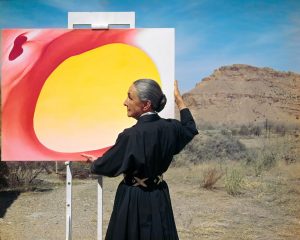
By Sandra Schulman
Floating bones and flowers in the Southwestern sky are the most famous images produced by Georgia O’Keeffe. As a woman and an artist, O’Keeffe was a mass of artful contradictions, due to her sensual abstract work and her monastic personal style.
As her life as an artist evolved, she became a self-created masterpiece with a progressive, independent lifestyle crafted through her clothing and the way she posed for the camera for some of the world’s top photographers.
A new exhibition at the Norton, Georgia O’Keeffe: Living Modern, brings all these elements together for the first time to give an eye-opening understanding of O’Keefe with her wardrobe alongside key paintings and photographs of O’Keeffe and her homes by Alfred Stieglitz, Ansel Adams, Annie Leibovitz, Philippe Halsman, Yousuf Karsh, Cecil Beaton, Andy Warhol, Bruce Weber, Todd Webb, and others.
The knockout show is the largest the Norton has produced since its $100 million renovation. It walks viewers through her life in sections separated in different colored rooms that start with her early school years, when O’Keeffe began to don severe clothing, a signature that would continue the rest of her life with a mostly black-and-white palette, shawls, capes, buttoned-up-to-the-neck blouses and big-brimmed black hats.
A film loop of O’Keeffe and her mentor lover Alfred Steiglitz bounding through the streets of 1940s New York is exuberant as the couple cloak themselves in their joy of the energy of the big city. O’Keeffe painted the bridges and skylines of Manhattan – a wonderful bridge painting is on display here – that shows her veering into abstraction even then.
But her love affair with New York wore off as a coveted commission for Radio City Music Hall fell through along with her relationship. She decamped to New Mexico, where the colors and skies and hills and stark wildness of the place enchanted her and became her most famous subject.
The clothing on display here mimics her artistic journey. O’Keeffe sewed many of the garments herself, and wore petite Ferragamo ballet flats in a just a few colors. When she found an item she liked, she repurchased it in many fabrics, as displayed in a rack of eight wrap dresses all the same in shades of black, gray, white, blue and a rare pink number.

Her flat black Mexican-style hat gets its own case here along with one of her bandannas. The most impressive piece is a pin made for her by the sculptor Alexander Calder that mimics her initials: “OK” – she wears it constantly in photos alongside the glass case-enclosed pin.
She seemed to always know how to present herself, as seen in the intimate photos taken of her by Stieglitz. Her celebrity brought the world’s most famous photographers to the desert. The portraits on display here are staggering in their depictions of this stoic high priestess loner of the desert, stalking the sands of New Mexico with her dogs in black crepe dresses and in her rock-and-bone-filled adobe home called Ghost Ranch.
She lived almost 100 years. After Stieglitz’s death, she lived permanently in New Mexico, though she traveled to Hawaii and Japan and created a body of work inspired by the zen nature of the Far East.
Her painted flowers became controversial symbols of femininity. She said: “When you take a flower in your hand and really look at it, it’s your world for the moment. I want to give that world to someone else. Most people in the city rush around so, they have no time to look at a flower. I want them to see it whether they want to or not,” she said.

O’Keeffe refused to join the feminist art movements or cooperate with any all-women projects, as she disliked being called a “woman artist” and wanted to be considered just an “artist.”
O’Keeffe became frail in her late 90s, moved closer to the nearby city of Santa Fe in 1984, and died on March 6, 1986, at the age of 98. Her body was cremated and her ashes were scattered, as she wished, on the land around Ghost Ranch. After her death, the Georgia O’Keeffe Museum was established in Santa Fe.
“I’ve been absolutely terrified every moment of my life — and I’ve never let it keep me from doing a single thing I wanted to do,” she said towards the end. “Filling a space in a meaningful way, that is what art means to me.”
The serene gaze, the tough spirit, the severe clothes and the cinematic quality of the portraits of her give this show a never-before-seen intimate feel for the life well lived by this extraordinary artist and true American original.
Georgia O’Keeffe: Living Modern runs through Feb. 2 at the Norton Museum of Art, West Palm Beach. Admission: $18, except Friday and Saturday, when admission is free; hours: 10 am to 5 pm Monday, Tuesday, Thursday and Saturday; 11 am to 5 pm Sunday; 10 am to 10 pm Fridays. Call 832-5196 or visit www.norton.org for more information.